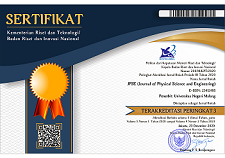The Impact of Electric Vehicle on Road Transportation in Indonesia: Energy Demand and CO2 Emission
Abstract
Light Duty Vehicle (LDV) for road transportation in Indonesia is the biggest energy consumption with most of the energy carriers from refined fuel oil with high CO2 emission. Battery Electric Vehicle (BEV) is one of the alternatives to reduce oil consumption and CO2 emission on the road transportation sector. This research is carried to analyse impact on BEV on energy demand and carbon emission. Modified Mobility Model (MoMo) with PUCE methods was developed to projecting road transportation demand in Indonesia. This research shows that road transportation will reach 519 MBoe in 2040 with 83.6% from refined fuel oil. With moderate EV, energy will be reduced by 31 MBoe (6%), and refined fuel oil reduced by 8.5%. With a high EV scenario, energy will be reduced by 57 MBoe (14%) and refined fuel oil reduced by 16%. CO2 emission will be reduced up to 4.8 to 8.8% in 2040.
Keywords
Full Text:
PDFReferences
A. C. Adi et al., Eds. Handbook of Energy & Economic Statistics of Indonesia. Jakarta: Ministry of Energy and Mineral Resources Republic of Indonesia, 2018.
S. Abdurrahman et al., Eds. Indonesia Energy Outlook 2018. Jakarta: Ministry of Energy and Mineral Resources Republic of Indonesia, 2018.
Subdirectorate of Statistical Mining and Energy, Energy Balances of Indonesia 2014-2018. Jakarta: BPS-Statistic Indonesia, 2019.
International Energy Agency, CO2 Emissions from Fuel Combustion 2018 Highlights. Paris: International Energy Agency, 2018.
International Energy Agency, Global EV Outlook 2019: Scaling-Up The Transition to Electric Mobility. Paris: International Energy Agency, 2019.
M. Huda, M. Aziz, and K. Tokimatsu, “The future of electric vehicles to grid integration in Indonesia,” Energy Proc., vol. 158, pp. 4592–4597, 2019.
F. Mwasilu, J. J. Justo, E. K. Kim, T. D. Do, and J. W. Jung, “Electric vehicles and smart grid interaction: a review on vehicle to grid and renewable energy sources integration,” Renew. Sust. Energ. Rev., vol. 34, pp. 501–516, 2014.
I. Jonan, Rencana Umum Ketenagalistrikan Nasional 2019-2038. Jakarta: Kementerian Energi dan Sumber Daya Mineral, 2019.
A. R. Holdway, A. R. Williams, O. R. Inderwildi, and D. A. King, “Indirect emissions from electric vehicles: emissions from electricity generation,” Energy Environ. Sci., vol. 3, no. 12, p. 1825, 2010.
International Energy Agency, Energy Technology Perspectives 2017. Paris: International Energy Agency, 2017.
A. Widyaparaga et al., “Scenarios analysis of energy mix for road transportation sector in Indonesia,” Renew. Sust. Energ. Rev., vol. 70, pp. 13–23, 2017.
L. Fulton, P. Cazzola, and F. Cuenot, “IEA Mobility Model (MoMo) and its use in the ETP 2008,” Energy Policy, vol. 37, no. 10, pp. 3758–3768, 2009.
Subdirectorate of Demographic Statistics, Technical Note Indonesia Population Projection 2015-2045: Result of SUPAS 2015. Jakarta: BPS-Statistic Indonesia, 2018.
Subdirectorate of Transportation Statistics, Land Transportation Statistics 2017. Jakarta: BPS-Statistic Indonesia, 2018.
J. Wacik, Peraturan Menteri ESDM No. 25 Tahun 2013 tentang Perubahan atas Peraturan Menteri Energi dan Sumber Daya Mineral Nomor 32 Tahun 2008 tentang Penyediaan, Pemanfaatan, dan Tata Niaga Bahan Bakar Nabati (Biofuel) Sebagai Bahan Bakar Lain. Jakarta: Kementerian Energi dan Sumber Daya Mineral, 2013.
International Energy Agency, Power Generation from Coal: On-Going Developments and Outlook. Paris: International Energy Agency, 2011.
U.S. Environtmental Protection Agency, Fuel Economy Guide Model Year 2020. Washington, D. C.: U.S. Department of Energy, 2020.
Intergovernmental Panel of Climate Change, “IPCC emission factor database,” in UN Climate Change Conference, Katowice, Poland, 2018.
J. P. Stempien and S. H. Chan, “Comparative study of fuel cell, battery and hybrid buses for renewable energy constrained areas,” J. Power Sources, vol. 340, pp. 347–355, 2017.
N. O. Nylund and K. Erkkilä, “Heavy-duty truck emission and fuel consumption simulating real-world driving in laboratory condition,” in 2005 DEER Conf., Chicago, Illinois, USA, Aug. 2005, p. 23.
Copyright (c) 2020 Arif Yulianto Widi Kurniawan, Ahmad Agus Setiawan, Arief Budiman

This work is licensed under a Creative Commons Attribution-ShareAlike 4.0 International License.
This work is licensed under a Creative Commons Attribution-ShareAlike 4.0 International License




















